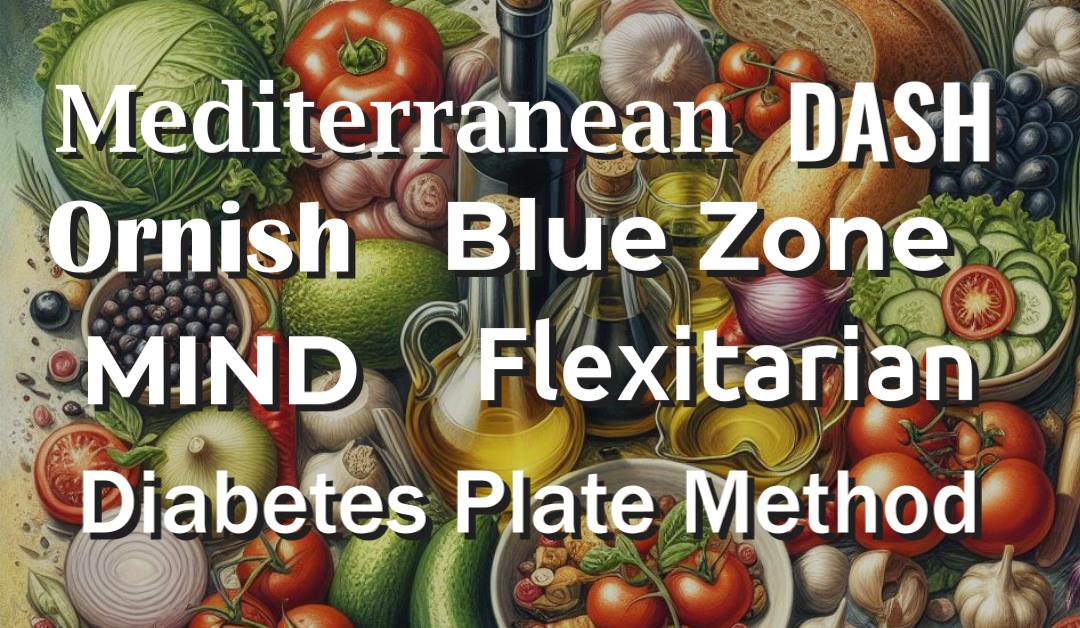Those of with diabetes leaned early on when it comes to managing diabetes, there isn’t a one-size-fits-all diet. However, there are strategies that can help us decide what to eat. Here are some key points:
- Balanced Eating: Focus on a balanced diet that includes a variety of nutrient-rich foods. This means incorporating whole grains, lean proteins, healthy fats, and plenty of fruits and vegetables.
- Carbohydrate Management: Carbohydrates significantly impact blood sugar levels. Monitoring carb intake is crucial. Some people find success with low-carb diets, while others follow a consistent carb-counting approach.
- Glycemic Index (GI): Consider the GI of foods. Low-GI foods have a slower impact on blood sugar levels. Examples include whole grains, legumes, and non-starchy vegetables.
- Portion Control: Pay attention to portion sizes. Eating too much, even of healthy foods, can affect blood sugar levels.
- Regular Meals: Aim for regular meal times to maintain stable blood sugar levels. Skipping meals can lead to fluctuations.
- Healthy Fats: Include sources of healthy fats, such as avocados, nuts, and olive oil. These can help manage blood sugar and overall health.
- Limit Added Sugars: Minimize foods and drinks with added sugars. Opt for natural sweetness from fruits.
- Consult a Professional: Work with a registered dietitian or healthcare provider to create a personalized meal plan based on your specific needs, preferences, and health goals.
Remember, the goal is to maintain stable blood sugar levels while enjoying a nutrient-dense and satisfying diet.
In this article we’ll explore the most popular diet plans for managing diabetes, including the Mediterranean Diet, DASH Diet, Ornish Diet, MIND Diet, Flexitarian Diet, Blue Zone Diet, and the Diabetes Plate Method.
Did you know that the Mediterranean Diet, with its emphasis on fruits, vegetables, whole grains, and healthy fats, has been associated with better glucose metabolism and insulin sensitivity in diabetes management?
Or that the DASH Diet, which focuses on fruits, vegetables, whole grains, and lean proteins, has demonstrated its efficacy in improving insulin sensitivity and managing diabetes effectively, while also lowering blood pressure and reducing the risk of heart disease?
And have you heard of the Flexitarian Diet, which offers individuals the flexibility to enjoy plant-based foods while allowing occasional meat consumption, providing a balanced and adaptable approach to diabetes management?
By understanding the key principles and guidelines of these popular diet plans, you can gain valuable insights into how specific dietary approaches can positively impact your diabetes management and overall well-being.
This article is a brief overview of the eating plans. If you can do so, it’s always important to work with a registered dietitian or certified diabetes educator to help create a meal plan that works for your particular needs.
So, let’s get started on your journey to a healthier you!

Managing Diabetes with the Marvelous Mediterranean Diet
The Mediterranean Diet is currently considered the most widely used of the diet approaches I’ll be discussing in this article.
The Mediterranean diet is a healthy eating plan that emphasizes whole foods, such as fruits, vegetables, whole grains, legumes, nuts, and seeds. It also includes healthy fats, such as olive oil, and moderate amounts of fish, poultry, and dairy products.
According to the CDC, the Mediterranean diet has been shown to improve A1C levels, cholesterol, and heart health in people with diabetes . The diet can help reduce insulin resistance, which leads to better blood sugar management and lower A1C levels 1.
Additionally, the Mediterranean diet can help improve heart health by reducing the risk of heart disease and stroke. inked to better glucose metabolism and insulin sensitivity, which makes it perfect for diabetes management. For example, olive oil, which is a staple in the Mediterranean Diet, has been linked to lower fasting insulin levels and improved blood sugar control in individuals with diabetes.
Plus, omega-3-rich fish, which is a key component of this diet, has been associated with reduced inflammation and improved lipid profiles, which are vital for cardiovascular health in diabetes management.
If you’re looking to incorporate the Mediterranean Diet into your daily life, there are some practical strategies you can use. As with all diet plans, meal planning and portion control are the starting point those of us with diabetes take for granted.
Here are examples of three meals using the Mediterranean Diet:
- Breakfast: Greek yogurt with fresh berries and chopped walnuts. This meal provides protein, calcium, antioxidants, and healthy fats. You can also add some cinnamon for extra flavor and blood sugar benefits.
- Lunch: Lentil and vegetable soup with whole wheat pita bread and hummus. This meal is rich in fiber, protein, iron, and vitamins. You can also drizzle some olive oil and lemon juice over the soup for extra flavor and healthy fats.
- Dinner: Baked salmon with roasted vegetables and quinoa. This meal is high in omega-3 fatty acids, which can help lower inflammation and improve heart health. You can also season the salmon and vegetables with herbs and spices for extra flavor and antioxidants.

DASHing Your Way to a Healthier Life
The DASH (Dietary Approaches to Stop Hypertension) diet is a healthy eating plan that emphasizes whole foods, such as fruits, vegetables, whole grains, lean proteins, and low-fat dairy products. According to Mayo Clinic, the DASH diet can help lower blood pressure, improve heart health, and reduce the risk of stroke.
In addition to these benefits, the DASH diet can also be beneficial for people with diabetes. According to Beyond Type 2, the DASH diet can improve blood sugar management, insulin sensitivity, hyperlipidemia, and promote weight loss, all of which decrease the risks of type 2 diabetes and are conducive to diabetes management.
However, it’s important to note that the traditional DASH diet may be too high in carbohydrates for your particular needs.
Here examples of three meals using the DASH diet plan:
- Breakfast: Oatmeal with fresh blueberries and sliced almonds. This meal provides fiber, antioxidants, and healthy fats. You can also add some low-fat milk or yogurt for extra protein and calcium.
- Lunch: Turkey and cheese sandwich on whole wheat bread with lettuce, tomato, and mustard. This meal is high in protein and whole grains. You can also have a side salad with low-fat dressing and a piece of fruit for more vitamins and minerals.
- Dinner: Chicken and vegetable stir-fry with brown rice. This meal is rich in lean protein and colorful vegetables. You can also use low-sodium soy sauce and sesame oil for flavor and healthy fats .
.

The Ornish Diet: A Delicious and Diabetes-Friendly Dietary Delight
The Ornish diet is a vegetarian eating plan that emphasizes whole foods, such as fruits, vegetables, whole grains, and legumes.
Renowned for its low-fat, plant-based eating plan, it offers a comprehensive approach to diabetes management that focuses on weight loss, improved insulin sensitivity, and reduced risk of heart disease.
According to US News Health, the Ornish diet aligns with American Diabetes Association guidelines by emphasizing whole grains and produce and avoiding saturated fat and cholesterol 1.
One study from 2010 showed that Ornish dieters decreased their hemoglobin A1C levels by 0.4 percentage points after a year, which is a measure of blood sugar control 1. The Ornish diet can also help improve heart health, reduce the risk of heart disease, and promote weight loss 2.
Overall, the Ornish diet is a healthy and balanced eating plan that can provide numerous benefits for people with diabetes.
Here are some examples of three meals using the Ornish diet plan:
- Breakfast: Oatmeal with fresh berries and chopped walnuts. This meal provides fiber, antioxidants, and healthy fats. You can also add some cinnamon for extra flavor and blood sugar benefits.
- Lunch: Lentil and vegetable soup with whole wheat pita bread and hummus. This meal is rich in fiber, protein, iron, and vitamins. You can also drizzle some olive oil and lemon juice over the soup for extra flavor and healthy fats.
- Dinner: Tofu and vegetable curry with brown rice. This meal is high in protein and spices, which can help lower inflammation and improve blood sugar management. You can also use low-fat coconut milk and low-sodium vegetable broth for the curry sauce .

Mindful Munching: The MIND Diet for Diabetics
The MIND Diet, a fusion of the Mediterranean Diet and the DASH Diet, presents a unique approach to diabetes management by focusing on brain-healthy foods that support cognitive function and overall well-being.
This dietary pattern emphasizes the consumption of foods such as leafy greens, berries, nuts, olive oil, and moderate amounts of fish, poultry and dairy products. all of which play a crucial role in promoting cognitive health and reducing the risk of developing neurodegenerative conditions, such as Alzheimer’s disease.
For individuals with diabetes, the MIND Diet offers a structured approach to nourishment that supports both their physical and cognitive well-being, presenting a holistic strategy for diabetes management.
According to US News Health, one study evaluated the association between following the MIND diet and the risk of having metabolic syndrome, a cluster of health problems that increases the risk for diabetes, and found that the MIND diet was associated with a lower risk of metabolic syndrome.
Multiple studies and reviews have shown that following a Mediterranean-style diet, which the MIND diet incorporates, can reverse or reduce the risk of developing Type 2 diabetes.
Here are examples of three meals using the MIND diet:
- Breakfast: Oatmeal with fresh blueberries and sliced almonds. This meal provides fiber, antioxidants, and healthy fats. You can also add some low-fat milk or yogurt for extra protein and calcium .
- Lunch: Turkey and cheese sandwich on whole wheat bread with lettuce, tomato, and mustard. This meal is high in protein and whole grains. You can also have a side salad with low-fat dressing and a piece of fruit for more vitamins and minerals .
- Dinner: Chicken and vegetable stir-fry with brown rice. This meal is rich in lean protein and colorful vegetables. You can also use low-sodium soy sauce and sesame oil for flavor and healthy fats.

The Flexitarian Fix for Diabetes: A Fun and Flavorful Way to Manage Your Health
The Flexitarian Diet is all about eating healthy plant-based foods like fruits, veggies, whole grains, legumes, and nuts, while still enjoying meat and animal products occasionally. This diet has been linked to supporting weight management and blood sugar control in individuals with diabetes. Plus, it’s packed with essential nutrients, dietary fiber, and antioxidants that are beneficial for diabetes management.
If you’re looking to incorporate the Flexitarian Diet into your daily life, there are some practical tips you can use. Meal planning and recipe modifications are great ways to get started.
By incorporating plant-based proteins such as tofu, tempeh, and legumes into your recipes, you can align with the principles of the Flexitarian Diet and enjoy a variety of nutritious and satisfying meals.
Additionally, gradually introducing meatless options and experimenting with diverse flavors and ingredients can empower you to make informed dietary choices that positively impact your overall health and well-being.
Here are examples of three meals using the Flextarian Diet:
- Breakfast: Oatmeal with fresh blueberries and sliced almonds. This meal provides fiber, antioxidants, and healthy fats. You can also add some cinnamon for extra flavor and blood sugar benefits.
- Lunch: Turkey and cheese sandwich on whole wheat bread with lettuce, tomato, and mustard. This meal is high in protein and whole grains. You can also have a side salad with low-fat dressing and a piece of fruit for more vitamins and minerals.
- Dinner: Tofu and vegetable curry with brown rice. This meal is high in protein and spices, which can help lower inflammation and improve blood sugar management. You can also use low-fat coconut milk and low-sodium vegetable broth for the curry sauce.

Blue Zone Basics: Controlling your Blood Sugar With This Plant-Based Plan
The Blue Zone Diet is rooted in the dietary patterns observed among the world’s longest-living populations, collectively referred to as the Blue Zones. These communities are characterized by exceptional longevity and remarkably low rates of chronic diseases, including type 2 diabetes.
This dietary approach emphasizes the consumption of whole, unprocessed foods, focusing particularly on plant-based ingredients. It encourages individuals to make plant-based foods the foundation of their meals, while limiting the consumption of processed foods and sugary beverages.
Several key principles guide the Blue Zone Diet, promoting health and well-being, including specific benefits for managing type 2 diabetes. One such principle is the 95% rule, which encourages individuals to make plant-based foods the foundation of their meals, reserving a small portion of the plate for other protein sources.
This approach ensures a high intake of fiber, vitamins, and minerals and reduces the intake of saturated fats and cholesterol, which can be beneficial for managing blood sugar levels and maintaining heart health.
The Blue Zone Diet also includes moderate amounts of lean proteins, such as fish, poultry, and eggs, complementing the plant-based focus of the diet. Additionally, it emphasizes the consumption of healthy fats, like those found in olive oil, avocados, and nuts, while discouraging the intake of processed foods and sugary beverages.
By following these principles, individuals can create a well-rounded, nutritious diet that not only aids in managing diabetes but also supports overall health.
Here are examples of three meals using the Blue Zone Diet:
- Breakfast: Oatmeal with fresh blueberries and sliced almonds. This meal provides fiber, antioxidants, and healthy fats. You can also add some cinnamon for extra flavor and blood sugar benefits.
- Lunch: Lentil and vegetable soup with whole wheat pita bread and hummus. This meal is rich in fiber, protein, iron, and vitamins. You can also drizzle some olive oil and lemon juice over the soup for extra flavor and healthy fats.
- Dinner: Baked salmon with roasted vegetables and quinoa. This meal is high in omega-3 fatty acids, which can help lower inflammation and improve heart health. You can also season the salmon and vegetables with herbs and spices for extra flavor and antioxidants.

Dividing it Up: The Diabetes Plate Method for Managing Diabetes
The Diabetes Plate Method serves as a practical and effective way to plan balanced, diabetes-friendly meals, providing individuals with a structured approach to controlling portion sizes and regulating carbohydrate intake for better blood sugar management. By dividing the plate into specific food groups, such as nonstarchy vegetables, lean protein, and carbohydrate-containing foods, this method simplifies meal planning and encourages balanced and nutritious eating habits, aligning with the dietary guidelines recommended for diabetes management.
Practical tips for incorporating the Diabetes Plate Method into daily life encompass various strategies, including meal portioning and mindful eating techniques. By being mindful of the types and quantities of carbohydrates consumed, individuals can better regulate their glucose levels, leading to improved diabetes management. Additionally, incorporating mindful eating strategies, such as savoring each bite and paying attention to hunger and fullness cues, can further support individuals in making conscious and healthful food choices throughout the day, promoting better blood sugar control and overall well-being.
In addition to its physiological benefits, the Diabetes Plate Method offers psychological and emotional advantages that support diabetes management. Its structured and straightforward approach to meal planning empowers individuals to take charge of their dietary habits and make informed choices about their nutrition, fostering a sense of autonomy and well-being. By embracing the dietary and lifestyle practices associated with the Diabetes Plate Method, individuals can enhance their diabetes management efforts and cultivate a profound sense of holistic well-being.
Here are examples of three meals using the Diabetes Plate Method.
- Breakfast: Scrambled eggs with spinach and cheese, whole wheat toast, and a small orange. This meal provides protein, fiber, calcium, and vitamin C. You can also have a glass of low-fat milk or water to drink.
- Lunch: Chicken and vegetable salad with low-fat dressing, whole wheat pita bread, and hummus. This meal is rich in lean protein, fiber, iron, and healthy fats. You can also have a cup of low-fat yogurt or a piece of fruit for dessert.
- Dinner: Beef and broccoli stir-fry with brown rice. This meal is high in protein, fiber, and antioxidants. You can also use low-sodium soy sauce and sesame oil for flavor and healthy fats.
In conclusion, the popular diet plans discussed, including the Mediterranean Diet, DASH Diet, Ornish Diet, MIND Diet, Flexitarian Diet, Blue Zone Diet, and the Diabetes Plate Method offer valuable support for managing diabetes through proactive dietary choices. Each of these diet plans presents a unique set of principles and guidelines that cater to the specific needs of individuals with diabetes, offering a diverse array of strategies to support their overall well-being and effectively manage their condition.
It is important to recognize that a one-size-fits-all approach does not apply to diabetes management, and consulting with healthcare professionals or dietitians is crucial for tailoring a meal plan that aligns with your specific nutritional needs and diabetes management goals.
These professionals can provide personalized guidance on how to integrate the dietary principles of these popular plans into daily life and offer ongoing support and adjustments as needed. By actively engaging with healthcare providers and nutrition experts, we can effectively leverage these diet plans to better manage our diabetes, improve overall health, and reduce the risk of complications associated with the condition.
###
Remember, self-care matters. Every step we take, every decision we make to better manage our diabetes makes a difference in how well and how long we live. Choose wisely. Live long, love life and be well.
The information on this site is not intended or implied to be a substitute for professional medical advice, diagnosis or treatment. The information on this site is for informational purposes only and is not intended to diagnose, treat, or cure any type of disease or condition. Diabetes Control Today does not guarantee any results for your specific situation. In support of our website, we may share resources offered by trusted partners. If you purchase products from any of these partners, the owners of this site may receive a portion of the proceeds. These affiliations allow us to continue bringing you valuable, potentially life-changing content.






